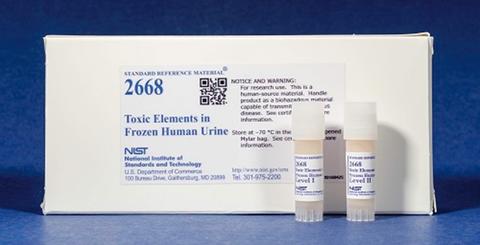Summary
For the past 25 years NIST has developed a number of biological fluid and tissue Standard Reference Materials (SRMs) primarily for clinically important analytes (e.g., cholesterol, glucose, creatinine, and trace elements). The Centers for Disease Control and Prevention (CDC) and the New York (NY) State Department of Health along with other state agencies are conducting studies such as the National Health and Nutrition Examination Survey (NHANES) that require the analysis of a large number of samples obtained from study subjects for clinically important analytes and for contaminants.
Description

SRM 2668 Toxic Elements in Frozen Human Urine
The development of SRMs to support measurements for contaminants in biological fluids and tissues will expand quality assurance capabilities to important species critical to human health. We will provide SRMs that are representative of the analytical challenges that may be encountered by analysts in all segments of the biomonitoring community. We will employ results from multiple analytical methods at NIST and data provided by collaborating laboratories to characterize the chemical composition of natural-matrix SRMs. We will also develop robust methods of analysis for use by the biomonitoring community.
Major Accomplishments
- Two human serum SRMs and two human milk SRMs have been value assigned for a wide range of organic contaminants based on methods performed at NIST, CDC, and four additional collaborating laboratories.
- Two popular SRMs for elements are being renewed, SRM 1598a Animal Serum and SRM 1577c Bovine Liver
- SRM 955c Lead in Caprine Blood has been released with four concentration levels of lead and other toxic elements in goat blood.
- SRM 2669 Arsenic Species in Frozen Human Urine and SRM 3669 Arsenic Species in Frozen Human Urine, Elevated Levels have been released with a total of three levels of seven arsenic species in human urine.
- SRM 2668 and SRM 3668 meet the expand needs for the measurement of lead, arsenic, barium, beryllium, cadmium, chromium, cobalt, cesium, iodine, manganese, mercury, molybdenum, nickel, platinum, antimony, thallium, tungsten, uranium, and perchlorate in human urine.
Additional Technical Details
NIST and CDC are collaborating on the development of a wide variety of SRMs that will be useful to the biomonitoring community. These include organic contaminants in human serum, human milk, and human urine, lead in caprine blood (with input from the NY State Department of Health), elements in bovine liver and animal serum, arsenic species in human urine, and toxic elements in human urine. Methods have been developed at NIST and at CDC for these measurements, and the results from the independent methods are being combined to provide certified concentration values for contaminants in the different materials.
Associated Product(s)
-
SRM 1577c Bovine Liver - elements
-
SRM 1598a Animal Serum - 12 element, reference values for 5 elements, and information values for 6 elements.
-
SRM 1953 Organic Contaminants in Non-Fortified Human Milk -polychlorinated biphenyls (PCBs), chlorinated pesticides, polybrominated diphenyl ethers (PBDEs), mercury, trace elements
-
SRM 1954 Organic Contaminants in Fortified Human Milk -polychlorinated biphenyls (PCBs), chlorinated pesticides, polybrominated diphenyl ethers (PBDEs), mercury, trace elements
-
SRM 1957 Organic Contaminants in Non-fortified Human Serum -polychlorinated biphenyls (PCBs), chlorinated pesticides, polybrominated diphenyl ethers (PBDEs)
-
SRM 1958 Organic Contaminants in Fortified Human Serum - progress - polychlorinated biphenyls (PCBs), chlorinated pesticides, polybrominated diphenyl ethers (PBDEs)
-
SRM 2669 Arsenic Species in Frozen Human Urine - seven arsenic species
-
SRM 3668 Mercury, Perchlorate, and Iodine in Frozen Human Urine - mercury, perchlorate, and iodine
-
SRM 3669 Arsenic Species in Frozen Human Urine (Elevated Levels) - five arsenic species

